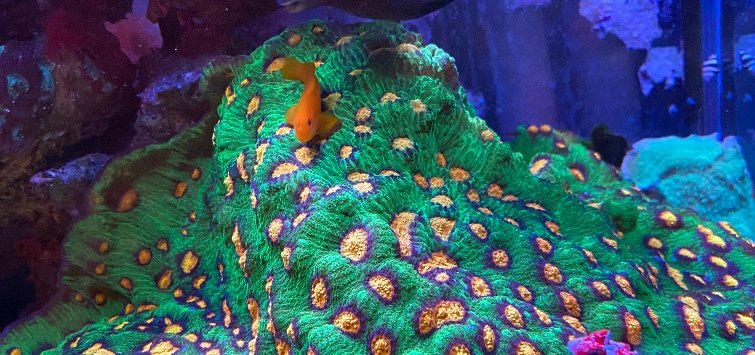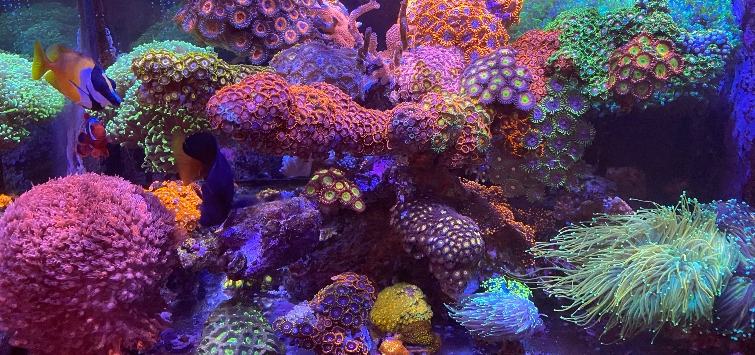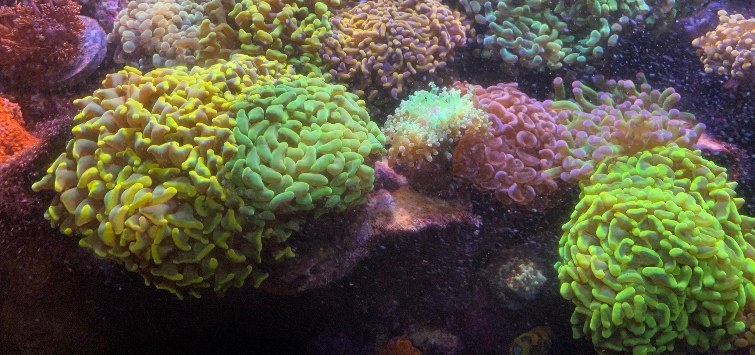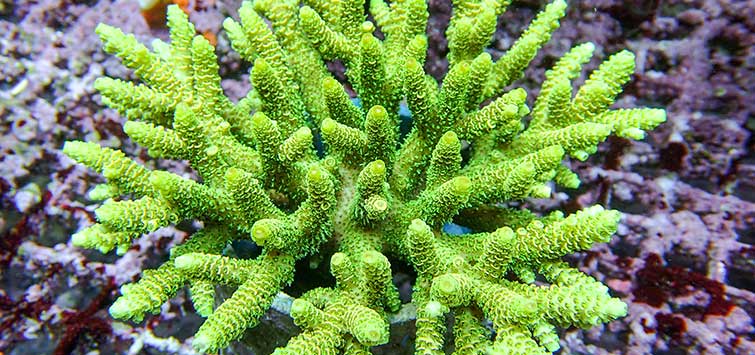Feeding Corals (and Other Inverts) in the Reef Tank
Author: Michael Paletta
Since the early days of the hobby, it has been an article of faith that feeding corals in our reef tanks is unnecessary. Give them bright light, strong flow, good water quality, and maybe some fish waste thrown in for good measure, and it was believed that the vast majority of corals would do just fine.
However, as we have learned and understood more about coral biology, reefkeepers have come to realize that our corals may indeed need more than just light and fish poop to thrive. When taking a closer look at most corals, and especially the small-polyp stony (SPS) corals, it becomes apparent that the portion of the coral’s body devoted to feeding and digestion is larger than just about any other part.Studies done by reefkeeping expert Dana Riddle and others found that corals get approximately 70 to 80 percent of their nutritional needs from their zooxanthellae and photosynthesis, 5 to 10 percent from bacterial consumption, and 10 to 20 percent from food consumption. So, while they are mostly okay with the bright lights that feed the zooxanthellae and fish poop supplying them bacteria, to meet their nutritional needs in a more complete and rounded fashion, they really should be fed.
While these revelations have been incorporated into our shared knowledge for a while, most of us in the reefkeeping hobby have largely been slow to do much about it. For my own part, I had tried feeding corals from time to time over the years without really seeing much impact in their health and well-being.
Fifteen years ago, I experimented with a coral food recipe from Italy consisting of a finely ground mixture of various seafood items and algae. I used it for a couple of months but did not see the miraculous results that some were touting, so I went back to not feeding my corals at all.
However, I now realize that when I did these feeding experiments years back, they were typically done too haphazardly to produce any reliable results. I would feed various amounts of different types of food at random time intervals, with no documentation of what I was doing nor serious thought to whether what was being fed actually met the coral’s needs. At the time I didn’t even make sure that the foods were of a size and type that could even be consumed by the corals.
Success in Feeding, and Breeding, Corals

All of this changed four years ago when I was fortunate enough to have the opportunity to visit Jamie Craggs at the Horniman Museum in London to see his revolutionary work on SPS coral spawning. At that time, Craggs was still mastering the art of maintaining the proper conditions for his corals to spawn. He concentrated on critical aspects such as the lunar cycle, salinity, and temperature fluctuations, light cycles that mimicked sunlight on the reef—and coral nutrition.
He has since mastered the process to the extent that he can now get many corals to spawn more often than the once yearly they do so in the wild.
During his research, Craggs found that providing proper coral nutrition was critical in getting corals to spawn. When he tried without providing proper nutrition, the corals either did not spawn, or had (for lack of a better term) a weak spawn.
While many of us over the years have had our corals thrive and grow in our tanks without providing them food, coral spawning in most closed systems has been, and still is, a relatively infrequent occurrence. However, with many hobbyists now working to provide better nutrition to our corals, that may be about to change.
After recently retiring from my former career in oncology, and having a bit more time on my hands in semi-isolation due to the pandemic, I have begun experimenting with various aspects of care for the animals in my reef tanks. One area of research has been the feeding habits of my corals, as well as the sizes and types of foods that they prefer.
This has largely been centered around applying what I have learned from Craggs’ work to my own corals in an attempt to replicate his success. I have now been doing this on a constant basis for the past year. In Craggs’ system coral feeding occurs daily over a two-hour period, with external filtration shut down but the flow within the system maintained, thus keeping the foods in circulation so the corals can feed. After the two hours, filtration is resumed, washing the food out of the system to keep any uneaten portion from becoming wastes.
To make sure the corals’ nutritional needs are met, he feeds a wide variety of foods that include amino acids, picoplankton, nanoplankton, microplankton, and mesoplankton. The specific foods used to accomplish this include commercial coral foods, Baker’s yeast, live Tetraselmis (phytoplankton), live Artemia (brine shrimp), dead Brachionus plicatilis (rotifers), Cyclops (copepods), fish eggs, and lobster eggs.
The corals exhibit a visible feeding response; within 15 minutes of feeding they began expelling mesenteric filaments—“feeding threads”—which are an indicator of feeding behavior in SPS corals. After feeding this diet for a prolonged period, egg and sperm packets were noted in the branches of many of the corals, a precursor to spawning and the best indicator I’m aware of that they are having their nutritional needs met.
Applying to My Own Setup
While I have tried to replicate Craggs’ program as closely as possible, since my system is considerably smaller than his, certain modifications have been made. Since I’m not aware of any perfect food that will meet all of a given coral’s nutritional needs, a wide variety of foods are fed to my corals nightly.I feed the SPS corals at night for two reasons: That’s when their polyp extension is greatest, and it’s also when the fish in the tank are least likely to consume the food before the corals can get to it. During feedings, my protein skimmers are shut down and the flow from the tank through the sump is reduced to keep the food from being removed from the system.
As in Cragg’s system, a wide variety of foods are fed, adding to his regimen such foods as oyster eggs, several dried commercial food preparations, and nutritional yeast. For the first six months, these foods were mixed up nightly and fed in a single combined mass when the lights went off. Over the past six months my feeding regimen has been changed slightly, and now, instead of a single large mass, the foods are added gradually over six hours, divided into smaller 3½ oz (100 ml) feedings. The gradual feedings over a longer period allow the corals to feed longer and help reduce waste.
Measuring Success
This tank was set up with coral fragments still too small to be capable of spawning, so I would have to measure success in terms of growth and overall health rather than the signs of reproduction evident in Craggs’ corals. Feeding seems to have increased their growth rate, which I could not only observe visually but also through measuring calcium consumption, which had increased by 40 percent since feeding commenced (though part of this is no doubt due simply to the corals’ naturally getting bigger over time). Two weeks after switching to the six-hour nightly feeding schedule, alkalinity consumption as well had increased by 20 percent. Additionally, either the nitrate production or consumption had changed, as I had to start adding nitrate to the system in order for any to be measurable.Learning how to feed corals, especially the SPS variety, is not without potential drawbacks. In addition to a lack of general knowledge about exactly which foods are best to feed, we also for the most part still do not know how much of it to feed. And excess feeding carries the risk of nutrient spikes and algae blooms, or a rapid accumulation of detritus leading to a cyano outbreak, or any number of other negatives that I have not experienced yet.
As such, in my experience it is best to start off adding only very small amounts of food for the corals at first, while keeping a sharp eye for any negative side effects. I also suggest, once feeding is commenced, to agitate the water in and around the live rock with a pump or bulb baster to remove any food that has settled, and siphon the bottom of the tank and sump at least weekly to remove any detritus that has settled there. Once a feeding response has been observed, and you start seeing better growth and coloration, the amount of food being fed can be gradually increased.
Feeding LPS Corals

While feeding SPS corals is a relatively recent advancement in the hobby, the feeding of large-polyp stony (LPS) corals has been going on for at least the past decade. In my 40-gallon (150-liter) nano reef, which is attached to the sump of my 500-gallon (1,900-liter) system, more aggressive feeding of the corals has occurred since the system was first set up.
This tank contains predominantly LPS corals, including Goniopora, Euphyllia, Lobophyllia, Blastomussa, Favia, and chalice corals. Since these corals are known to be heavy feeders, they have been target fed twice a week and the tank is broadcast fed six days a week. The corals are fed a “sludge” of the same foods used for the SPS corals, but the food is mixed with only a small amount of water before this thick paste is delivered to each coral via a pipette.
All water flow is shut off, both to the tank and within it, for 30 to 60 minutes after each feeding to allow the food to be taken in. Then the flow is returned, moving any leftovers off the corals and rocks and into the sump to be filtered out.
The corals in this aquarium have thrived and grown significantly as a result of this feeding regimen, but I must warn that this aggressive feeding of my LPS corals would not be possible if the tank they are housed in was not attached to the large sump and heavily filtered larger tank. If this nano tank was a stand-alone, it would be quickly fouled by the heavy feedings.
The rapid growth that has resulted from this feeding regimen has made it necessary to prune back the Goniopora and Euphyllia colonies once or twice a year. In addition, some of the Goniopora colonies have even dropped small clones of themselves. To see this type of growth is quite an improvement over the early years of the hobby, when Goniopora corals were thought to be impossible to keep. Feeding them has made it so that they now can not only be kept, but can now reproduce in our tanks as well.
Feeding Anemones and Other Invertebrates
One interesting side effect of this more aggressive feeding is that I have now been keeping a yellow feather star—a notoriously difficult to keep crinoid—alive and growing in the nano tank for the past 18 months. This may not seem long, but my previous success was a mere 3 months. Despite this success, I am not suggesting everyone go out and now buy crinoids, but simply that we may be coming along in understanding what it takes to keep them alive long term.And while feeding corals has produced at least some improvement in virtually every one of my specimens, feeding another of my invertebrates has produced an even greater effect. For the past year I have been feeding anemones directly once or twice a week with mysis shrimp. Prior to that, I relied on them getting food from their clownfish partners to stay alive and healthy.
Since I began feeding anemones directly, a significant change has occurred. First, they have gotten much bigger; anemones increase their number of tentacles in relation to how much food they are receiving. Second, they have begun splitting and reproducing new daughters on a regular basis. While the anemones did occasionally split before, since I started feeding them the splitting occurs more frequently.
Other hobbyists and coral propagators have reported this as well, which is why, in a very positive development, while imports of anemones from Indonesia have been reduced, there currently is no corresponding shortage of anemones in the hobby.
Coral Feeding Caveats
One caveat that should be noted is that feeding corals will only be beneficial to your system if accompanied by adequate and strong filtration. One of the reasons why learning how to feed corals may not have been a good idea during the early years of the hobby is that the filtration equipment employed back then was nowhere near as good as it is today.When corals were fed in those days, any nutritional benefit would have been outweighed by the rapid accumulation of wastes and detritus, reducing the water quality to the point where the feedings would hurt the corals more than benefit them. This is why, as filtration technology has improved, so too has our understanding of our coral’s nutritional needs, and today learning how to feed corals has become not only accepted, but now is the norm for many hobbyists.
But while the advantages of adequately feeding our corals and other invertebrates are at least to me indisputable, there are some risks if it is not done properly. Any change in your feeding regimen should be implemented slowly, testing along the way to ensure nutrient levels are not rising.
Another risk of improper feeding is that it can also lead to bouts of tissue necrosis (TN). TN can result when certain pathogenic strains of bacteria get out of control, which seems to result when some nutrients are at excessive levels and/or pH is too low—meaning the filtration is not keeping up with the increase in nutrients.
Lastly, trying to feed desired invertebrates can also lead to the feeding of undesirable invertebrates. Vermetid snails, tube worms, and bristleworms can all proliferate out of control if excess food is supplied to a tank. Any of these animals can become problematic if their populations get too high, so before a coral feeding program is commenced, care should be taken to remove as many of them as possible.
A Bright Future for Coral Husbandry
While the current method of feeding my corals seems to be working, I am still making plans to improve it. The next step is to begin feeding them live foods on a regular basis in hopes of replicating the success I saw in the tank of Enrico Ormetto, a reefkeeper in Italy. In his tank, which at the time I saw it was a little over 18 months old, the corals had grown from frags into colonies faster than I had ever seen before. His “secret” was in employing an automatic plankton reactor that fed the tank green water and live plankton on an almost daily basis.There have been numerous other reports about the benefits of feeding live foods to corals. Since I now have the time, my plan is to begin culturing green water and plankton to feed to the tank daily. It will be interesting to see if this is equal to or better than what is occurring as the result of feeding frozen and prepared foods.
With these advances in our knowledge of invertebrate husbandry, our successes will continue to increase as well. Seeing how far we have come in the keeping of marine organisms over the past 30 years is nothing short of amazing. Now we can not only keep most reef creatures alive in our closed systems, but also get many of them to reproduce.
As our understanding continues to improve and more products for these animals are developed, I fully expect even more successful reproduction of corals and other inverts to continue. In the future I expect the problem to shift from “How to we keep a certain coral alive?” to “What do you do with 10,000 coral planulae?” With continued improvements in coral nutrition, I predict coral spawning events, still a relative rarity in many hobbyist’s tanks, to become a common occurrence.
See the Full Article on TFH Digital http://www.tfhdigital.com/tfh/jan_feb_2021/MobilePagedReplica.action?pm=2&folio=24#pg27

.png?h=595&iar=0&w=2781&hash=5FD5E69473BCC22199FBFA2FB71B6033)



